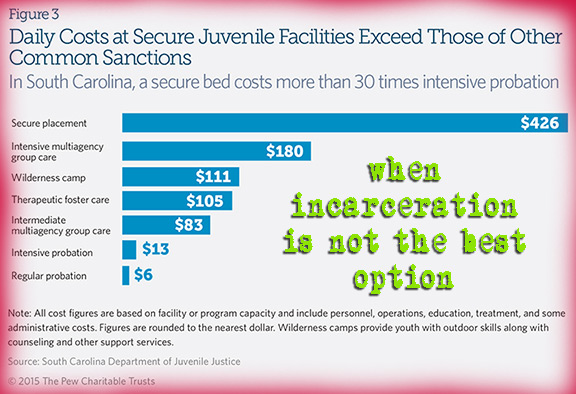NEW REPORT SHOWS STATES ARE STARTING TO RE-THINK PUTTING KIDS IN OUT-OF-HOME DETENTION
States are starting to replace the ineffective and expensive practice of incarcerating kids in residential facilities, choosing instead to keep kids with their families through community-based alternatives, according to a new Pew Charitable Trusts brief on the issue.
Research shows that out-of-home detention fails to reduce recidivism, and in many cases, makes kids more likely to reoffend.
A recent study in Texas found that kids housed in state detention facilities were 21% more likely to be arrested again within one year of release than their peers under community supervision.
And neither do longer stays in residential detention facilities lower recidivism rates.
A Ohio report revealed that kids kept locked up longer were much more likely to reoffend than kids detained for a shorter period.
Multiple studies reveal that states receive a paltry return on the millions of taxpayer dollars they spend on locking kids up.
In 2012, CA was spending around $180,000 annually to house each locked-up kid. And more than half of the state’s incarcerated kids reoffended within three years of release.
Many states are catching on and passing legislation to limit what types of offenses can land kids in out-of-home facilities, and for how long they can remain incarcerated.
In 2007, California banned sending kids to state facilities for low-level and nonviolent offenses. Several other states stopped putting kids in detention facilities for misdemeanors and other non-serious offenses. Mississippi even limited out-of-home placements in the state’s training camp to kids with violent felonies or more than three misdemeanors.
FBI FORENSIC HAIR EXAMINERS GAVE FLAWED TESTIMONY IN HUNDREDS OF TRIALS SPANNING DECADES
A federal review of 268 cases revealed 26 of 28 FBI forensic examiners overstated hair comparisons 95% of the time when giving forensic testimony against a defendant. According to the investigation, the examiners gave flawed testimony against 32 defendants facing death sentences, nine of whom have already been executed, and four of whom have since been exonerated.
But the Justice Department is not stopping at 268. Around 2,500 applicable cases from before the year 2000 (in which the lab reported hair matches) are slated for review.
The Washington Post’s Spencer Hsu has the story. Here are some clips:
The FBI errors alone do not mean there was not other evidence of a convict’s guilt. Defendants and federal and state prosecutors in 46 states and the District are being notified to determine whether there are grounds for appeals. Four defendants were previously exonerated.
The admissions mark a watershed in one of the country’s largest forensic scandals, highlighting the failure of the nation’s courts for decades to keep bogus scientific information from juries, legal analysts said. The question now, they said, is how state authorities and the courts will respond to findings that confirm long-suspected problems with subjective, pattern-based forensic techniques — like hair and bite-mark comparisons — that have contributed to wrongful convictions in more than one-quarter of 329 DNA-exoneration cases since 1989.
[SNIP]
The FBI is waiting to complete all reviews to assess causes but has acknowledged that hair examiners until 2012 lacked written standards defining scientifically appropriate and erroneous ways to explain results in court. The bureau expects this year to complete similar standards for testimony and lab reports for 19 forensic disciplines…
Federal authorities are offering new DNA testing in cases with errors, if sought by a judge or prosecutor, and agreeing to drop procedural objections to appeals in federal cases.
However, biological evidence in the cases often is lost or unavailable. Among states, only California and Texas specifically allow appeals when experts recant or scientific advances undermine forensic evidence at trial.
CHARACTER DEVELOPMENT PROGRAM “JOVEN NOBLE” HELPS AT-RISK LATINO BOYS NAVIGATE THE ROAD TO ADULTHOOD
In Santa Ana, where the incarceration rates for young Latino men are higher than anywhere else in Orange County, Joven Noble (Noble Young Man) seeks better outcomes for at-risk boys and young men through character development and restorative justice.
The culturally informed curriculum was developed by National Latino Fatherhood and Family Institute. Joven Noble provides young boys and men with an emotional outlet and important behavior skills.
The Santa Ana Boys and Men of Color has helped spread the curriculum to Santa Ana schools, where kids can enroll as an alternative to suspension.
The OC Register’s Alejandra Molina has more on Joven Noble and the boys the program has helped. Here’s a clip:
Here in Santa Ana, coordinators are hoping to reach Latino youth by instilling a “rites of passage” curriculum, or Joven Noble, that challenges the myth that manhood is defined by physical dominance and sex. Manhood, the practice says, is about honor, generosity and respect.
For Reyes, expressing his feelings proved a struggle. He said he rebelled after his older brother died. He would bottle up his feelings and resort to “punching something and making a hole in the wall.”
After learning about Joven Noble, his outlook is different.
Reyes now believes that real men respect women, and they’re responsible. They let out their emotions. “They actually get emotional,” he said.
[SNIP]
The program has its roots in South Los Angeles, Compton and Watts to address Latino youth struggling and “exhibiting their pain with substance abuse and gangs.”
Jerry Tello, director of the National Latino Fatherhood and Family Institute, who developed Joven Noble, said when programs honor one’s identity and culture, “problem behaviors begin to lessen.”
Teachers and counselors at pilot schools send a list to coordinators, or circle keepers, of 15 students who have displayed behavioral problems or who would benefit from the curriculum. Enrollment would be an alternative to suspension, Rios said.
Gathered in a circle, students can vent about their weekend or highlight something positive for the week. A lot of it is storytelling, having a conversation. Within those circle discussions, Rios said, “it gives us a space to re-establish the values, traditions.”
At the core of Joven Noble is redefining what it means to be a man.

